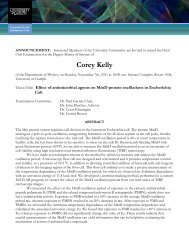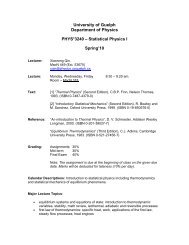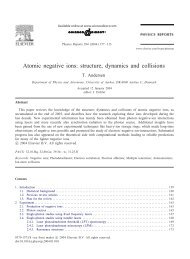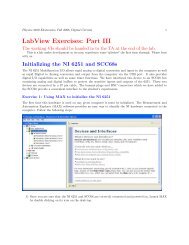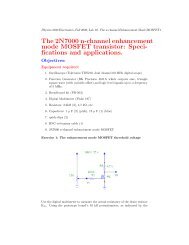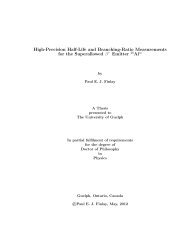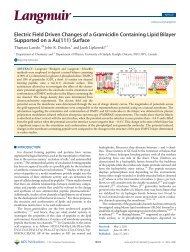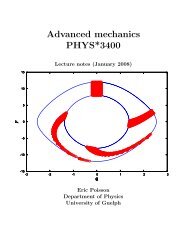Geant4 Simulations for the Radon Electric Dipole Moment Search at
Geant4 Simulations for the Radon Electric Dipole Moment Search at
Geant4 Simulations for the Radon Electric Dipole Moment Search at
Create successful ePaper yourself
Turn your PDF publications into a flip-book with our unique Google optimized e-Paper software.
as [47]<br />
I(E) =<br />
G<br />
2π 3 7 c 6 | M if | 2 (T 2 e +2T em e c 2 ) 1/2 (Q−T e ) 2 (T e +m e c 2 )F(Z,T e ) , (3.6)<br />
where G is a constant representing <strong>the</strong> strength of <strong>the</strong> weak interaction, M if is <strong>the</strong><br />
transition m<strong>at</strong>rix element, T e is <strong>the</strong> kinetic energy of <strong>the</strong> electron (or positron), Z is<br />
<strong>the</strong> proton number of <strong>the</strong> daughter and F(Z,T e ) is called <strong>the</strong> Fermi function.<br />
The Fermi function accounts <strong>for</strong> Coulomb effects between <strong>the</strong> emitted electron or<br />
positron and <strong>the</strong> charge of <strong>the</strong> daughter nucleus; due to <strong>the</strong> opposite charges of <strong>the</strong><br />
electron and positron <strong>the</strong>ir spectral intensities differ. For example in a semi-classical<br />
view of β − decay, <strong>the</strong> electron cre<strong>at</strong>ed in <strong>the</strong> decay of <strong>the</strong> neutron is held back by <strong>the</strong><br />
<strong>at</strong>tractive Coulomb <strong>for</strong>ce with <strong>the</strong> daughter nucleus decreasing <strong>the</strong> average energy<br />
of <strong>the</strong> emitted electrons. In β + decay, on <strong>the</strong> o<strong>the</strong>r hand, <strong>the</strong> positively-charged<br />
positron cre<strong>at</strong>ed by <strong>the</strong> decay of <strong>the</strong> proton is repelled by <strong>the</strong> Coulomb <strong>for</strong>ce with <strong>the</strong><br />
daughter nucleus increasing <strong>the</strong> average energy of <strong>the</strong> emitted positrons.<br />
The shape of <strong>the</strong> spectral intensity was calcul<strong>at</strong>ed in <strong>the</strong> RnEDM simul<strong>at</strong>ions <strong>for</strong><br />
every β branch to accur<strong>at</strong>ely describe <strong>the</strong> energy of <strong>the</strong> emitted electrons from <strong>the</strong><br />
decay of 223 Rn into 223 Fr. An analytic approxim<strong>at</strong>ion of <strong>the</strong> Fermi function was used<br />
to calcul<strong>at</strong>e <strong>the</strong> shape of <strong>the</strong> spectrum, given by [48]<br />
F(Z,E) ∼ = 4π(1+s)<br />
[<br />
[(2s)!] 2 (2pρ)2s−2 (s 2 +η 2 ) s−1/2 e<br />
s<br />
2φη−2s+<br />
6(s 2 +η 2 )<br />
]<br />
, (3.7)<br />
where s = [1−(Ze 2 /c) 2 ] 1/2 , ρ = R/(/mc), R is <strong>the</strong> nuclear radius approxim<strong>at</strong>ed<br />
as R = r ◦ A 1/3 with r ◦ = 1.2 fm and A <strong>the</strong> nuclear mass number, p is <strong>the</strong> electron (or<br />
positron) momentum (in units of mc), η = ±Ze 2 /ν (positive sign <strong>for</strong> β − decay and<br />
neg<strong>at</strong>ive<strong>for</strong>β + decay)andν is<strong>the</strong>electron(orpositron)velocity. Thisapproxim<strong>at</strong>ion<br />
does not account <strong>for</strong> electron screening, however this correction is important only <strong>at</strong><br />
very low energies (on <strong>the</strong> order of 100 keV or less) [48].<br />
45



